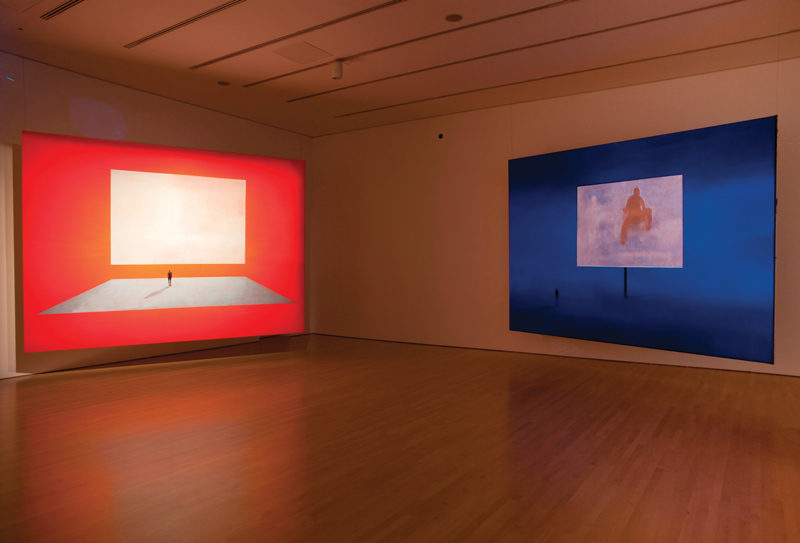[Fall 2011]
National Gallery of Canada, Ottawa
From February 18 to May 15, 2011
“Wanda Koop: On the Edge of Experience” is a major attraction of the Prairie Scene festival, the fifth presentation of this biannual event organized by the National Arts Centre in Ottawa to showcase Canadian regional art scenes. Koop’s show, a mid-career retrospective of sorts, consists of four chronologically arranged sections and offers a sampling from eight of the artist’s many series. The first two rooms display a selection of her iconic large-scale acrylic-on-wood paintings from the series Flying to the Moon (1984–87), paired with No Words (1987–89), followed by a choice from In Your Eyes (1997–2001), Sightlines (1999–2001), and Green Zone (2003–09). Viewers are then invited to experience Koop’s newest en-deavour, The Hybrid Human Project (2010), an affective installation that builds on the now-familiar large-scale works on plywood and adds projected video and sound, media with which she has been experimenting for some time.
Finally, we enter a re-creation of the artist’s studio, a problematic museological trope that curiously, in the case of Koop’s work, seems to make sense because we are able to see her image-centred meditative process. Viewing her many sketches, which come in the form of Post-it Notes drawings, small-scale acrylics, sketchbook pages, photographs, written notes, and films, we can see her research process. As childhood paintings are included as a part of this in-trospection of the artist’s creative process, a linear progression emerges with regard to her oeuvre. Themes can be traced throughout her career – particularly the evolution of the image from static to dynamic.
Much like Rothko, Koop pairs colours carefully. While Koop’s work is representational and Rothko’s decidedly not, both treat colour similarly and make demands on the viewer’s concentration. When asked to explain how her works evolve from pencil sketches to acrylic paintings, Koop responded, “When I make the notes I am already thinking in terms of colour. Colour is the vehicle for me. So, it may be a small shorthand note, but I’m thinking in colour.” This embryonic consideration of colour – which acts like a highlighter on a page of text, drawing out what is important – isolates the image that we are being asked to contemplate. Again, as in Rothko’s painting, in Koop’s work colour sets the images into motion on the picture plane. The representational nature of Koop’s work grounds it in the material – mundane images made unique through their transformation and isolation, another theme that is persistent throughout her oeuvre.
The selection of work from the 1980s highlights Koop’s focus on the representation of physical objects – the image. The monochrome background on which it is carefully painted creates an effect of reverberation – the image is brought into motion, brought to life through its isolation. As Mary Reid explains in the accompanying catalogue, the images, “lacking any surrounding ‘clues’ allow one to concentrate solely on the ‘sign,’ provoking an almost meditative state of looking.” Through this meditation, the sign is transformed from an impression of the world – such as a still photograph – into a reflection on it – a living image. The photographic basis for her later work is better understood in this context.
Koop’s work from the 1990s and 2000s invites our contemplation of the image in much the same way as do her earlier paintings; however, the nature of the image has shifted. This collection of work is inspired by personal travel and current events: a family pilgrimage to Russia (whence Koop’s family had fled prior to her birth in Vancouver, British Columbia, in 1951), and global conflict. Based on both memory and the instantaneous flashes of televised images of modern warfare, Koop paints from the other side of what W. J. T. Mitchell termed “the pictorial turn,” in which images replace text as our central mode of experience. Her expression and understanding are pictorial, but they are slow and carefully contemplated. The starting point for the series Green Zone was televised images of the war in Iraq. The saturation of front-line video imagery clearly made an impression on the artist, who sat in front of the television screen sketching frames on Post-its. These notes became the initial studies for the series. Koop’s incorporation of video into her newest project, then, is not unprecedented.
The Human Hybrid Project, installed in the final gallery, physically brings the viewer into the image. The use of multiple technologies – the incorporation of video, music, and paintings on plywood – makes this installation a truly immersive experience. Silhouettes of human bodies are painted and dancers projected onto abstracted landscapes. The music being played unites viewers with the dancers until the moment that they are caught in the light of the projector and their own silhouette enters the picture-plane. In that instant, they experience something of an epiphany: you were never not implicated in these images; through your careful contemplation of the images, the lines between image and “real” have been blurred.
Sheena Ellison is a Ph.D. student in cultural mediations at Carleton University in Ottawa. Her research focuses on modern and contemporary Canadian art, particularly the impact of the legacy of the Group of Seven on Contemporary First Nations art. An article on Huron-Wendat material culture will appear in a special issue of Cahiers métiers d’art ::: Craft Journal this fall.


